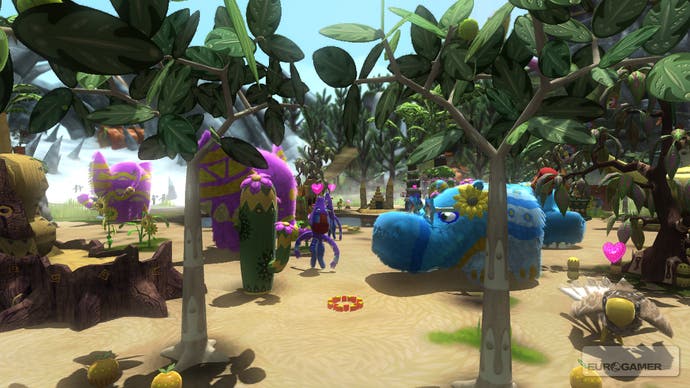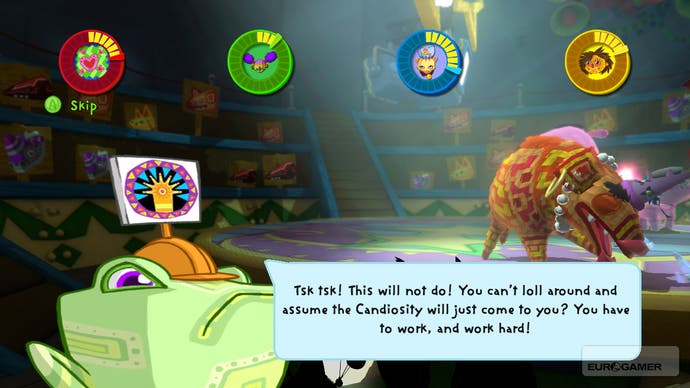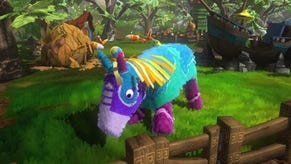Viva Piñata: Trouble in Paradise
Refilled with fun.
We loved Viva Piñata! But much as we loved Viva Piñata (and as much as we assaulted you with that love day after day for months afterwards), it's no secret it sold pretty badly. Over a million copies is decent going, but not quite the return you want after four years of hard slog. Certainly not if you're Rare, Microsoft's most expensive acquisition since the light - and everything else - went green on the Xbox project. So, we ask, beached on a futon in the bowels of Rare's idyllic countryside lair opposite two of the game's most senior developers, why do a sequel?
"We didn't have anything immediately to do," says lead designer Justin Cook, taking us back to November 2006 shortly after the game had shipped. "And I think it's natural certainly for programmers to start looking at things they've just done, tightening the screws, tweaking and doing that kind of thing." Lead programmer Will Bryan agrees. "There's always the things we'd thought about for the first game but hadn't done. But then there's also...you go on forums and things and people say, 'Can you do this?' and you go, 'No...you can't. That's a really good idea! Why didn't we think of that!' But then we've done so much that we never intended to for the sequel. People ask, 'Is it a genuine sequel?' and you think, 'Well, it's a genuine sequel and then some.'"
Viva Piñata: Trouble in Paradise is an easy game to sum up: more of the same, stuffed with better sweets. As before, it's about turning a neglected plot of land into a flourishing garden by laying grass, trees and flowerbeds - and most importantly it's about creating a home fit for the dozens of paper-skinned piñata animals lurking outside the borders, and balancing their needs and habits as you unlock better tools and more advanced decorations, which in turn attract more exotic species. It's the circle of life with horticulture and experience points.

The Trouble in Paradise interface is largely unchanged, but there are new arctic and desert regions to visit and trap piñata (and the option to lay sand or snow atop the soil in your main garden rather than grass alone), new elements like the Trick Stick and the Just for Fun mode (a less demanding sandbox, where you aren't so harried), and a host of new things to do with your piñata, including talent shows and even a racing mini-game. There's a Photo mode, too ("replacing the dodgy mobile phone pictures posted on forums", Bryan points out). And of course there are dozen of new piñatas - around 30 in total, from the desert-dwelling Camellos, Sweetles and Geckies, and the arctic Jelis, Robeans and Walrusks, to the new first animal, the Bispotti, and others like the Sarsgorilla, Hoghurt and Custacean. All beautiful.
The ability to refine rather than start again is arguably why Trouble in Paradise happened at all. "We basically had a running game, so instead of having to build it from scratch we could turn it around a lot faster," Cook explains. Some of this refinement is very focused, like a three-step tutorial to improve on the first game's cluttered opening, support for a larger number of simultaneous objects in the world, the option to plant multiple seeds without having to run back to the shop, and the ability to reach outside the borders of your garden, so you can check out a piñata's requirements without having to stand poised for when your elusive visitor trips within its borders.

These changes have blossomed into other new features and improvements. Being able to reach outside the garden border had several knock-on effects, for instance. "It allowed us to put things out there and take them off the menu, so again it was a more user-friendly experience," Cook explains. Just For Fun mode had hidden benefits too. Envisaged as a way of lowering the bar for kids, the addition of local two-player co-op suddenly meant it was ideal for kids to play while a parent or second player, who doesn't have to be logged in with a separate profile, stood by with a second pad to help out. "We've given them a new special ability," Cook reveals, "where if they do good things for your garden they gain magic power and it fills up their cursor with rainbow colours, and then you can use that power to make piñatas happy, or you can cure the sick piñatas, or you can tinker items. For me and one of my kids it's fantastic."











